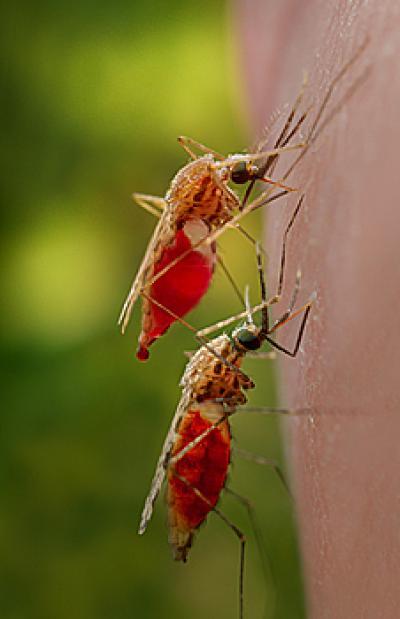Using advanced methodologies that pit drug compounds against specific types of malaria parasite cells, an international team of scientists have identified a potential new weapon and approach for attacking the parasites that cause malaria.
The disease is caused by Plasmodium parasites, which are transmitted to humans by the infectious bite of an Anopheles mosquito. Plasmodium vivax and Plasmodium falciparum are the most problematic of the parasite species. The former is the most widespread globally; the latter most deadly.
Since DDT was banned, malaria became a growing problem rather than a dwindling one. There have been alternative efforts at prevention and treatment in recent years but malaria remains one of the world's great infectious scourges. In 2010, according to the World Health Organization, there were an estimated 219 million cases globally and 660,000 deaths, mostly among African children.
Principal investigator Elizabeth A. Winzeler, PhD, professor in the Division of Pharmacology and Drug Discovery, Department of Pediatrics and director of translational research at the UC San Diego Health Sciences Center for Immunity, Infection&Inflammation, and colleagues found a key metabolic enzyme (phosphatidylinositol 4-kinase or PI4K) that is used for intracellular development by Plasmodium species at each stage of infection in the vertebrate host.

Anopheles gambiae mosquitoes are a key vector of malaria and carrier of the Plasmodium falciparum parasite. Credit: UC San Diego School of Medicine
A major obstacle has been the developmental nature of the P. vivax parasite. While some antimalarial drugs effectively kill P. vivax as it circulates in the host's bloodstream, the parasite also produces an early-stage form called a hypnozoite that can lie dormant and undetected in the livers of infected persons for years before reinitiating development and triggering relapse.
The discovery could have significant ramifications for eventually eradicating malaria as a global disease. "Elimination efforts are more effective with better tools and infrastructure," said Winzeler. "Clearly we have better infrastructure and communication now than we had in the 1960s. To make more progress, though, we need more effective drugs."
"Most drugs selectively work on certain stages of the (parasite) lifecycle, but not all stages," said Case McNamara, PhD, the study's first author and a researcher at the Genomics Institute of the Novartis Research Foundation in San Diego. "Therefore, inhibitors of this drug target have the potential to not only cure individuals of a malaria infection, but to also prevent infections and even block transmission of the parasite back to the mosquito."
Currently, the only licensed antimalarial drug capable of fully cleansing hidden hypnozoites and eliminating the possibility of relapse – known as the "radical cure" – is primaquine, a drug first tested in the 1940s and licensed by the Food and Drug Administration in 1952.
But primaquine has significant adverse side effects and shortcomings, according to Winzeler, most notably that it can cause life-threatening anemia in people with a specific inherited metabolic enzyme deficiency frequently found in malaria-endemic regions.
"In addition, it may not work all of the time and it requires a prolonged dosing schedule, up to 14 days, which means compliance is an issue. People often do not take the full dose," Winzeler said. "Primaquine is an old drug and it's not clear that it would ever be licensed in today's regulatory environment."
Primaquine was developed "by simply injecting a lot of compounds into monkeys and seeing which compound cured malaria infections," said Winzeler. It was later tested in humans using prisoners.
The new approach is far more finely tuned, based on a series of detailed cellular assays that seek to model different parasite lifecycle stages in miniature test tubes. The researchers looked for the rare compound class that had activities in all parasite stages, but no activity against human cells and which was also drug-like. A new chemical class, called imidazopyrazines, possessed these properties. The researchers then identified the protein target of these compounds as PI4K.
"(Dr. Winzeler) had a very creative and powerful idea to help identify malaria drug targets," said McNamara. "By patiently evolving drug-resistant parasites against the drug of interest, we can probe the genome for the changes responsible for conferring resistance.
"Fortunately, malaria parasites will often try to alter the drug target in subtle ways to prevent the drug from working effectively. So, by identifying these changes we, in turn, identify the drug target. This approach has worked so well that it has quickly become a standard technique in our field to help study and characterize all new antimalarials."
Because PI4K is also found in humans, Winzeler said the next challenge is to develop a superior drug that continues to discriminate between the parasite and human versions of this enzyme. “Since we know the identity of this protein and will hopefully soon solve its structure, this task will be much easier,” she said.”
Source: University of California - San Diego




Comments